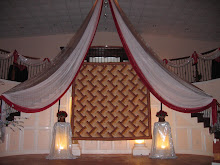I'm glad that C8 wanted a quilt of blues and greens. She got to choose and I only had to focus on those two colors. For the pattern she chose, I needed to purchase 20 fat quarters of blues and 20 of greens. Since there were going to be so many different, random fabrics involved, I decided to go with fabrics that didn't have any white in them. This would help it to look less scrappy.
This is a fabric I chose for the back. There was only 5 3/4 yds left on the bolt so I got it all. I might use this in the border on the front but I haven't decided yet. It's an awesome strong print and the colors are perfect.

The wrench that C8 threw in last week was she wanted a bit of pink in the quilt. So, I went out and bought some pink. I'm guessing maybe pink is on its way out, I'm not sure, but there wasn't as much pink in the store as usual. The only pink I found that would work had a little bit of white in it. I thought it through and decided it would work because the pink is only going to be used in the center squares and in the inner border. It won't be sharing time or space with the blues and greens.
 Sometimes I wish that there were a list of rules for choosing fabric. But, there's not. Of course.
Sometimes I wish that there were a list of rules for choosing fabric. But, there's not. Of course. There are a few tips that can be helpful, however.
First, trust your own style and what you like. Choose colors and patterns that please your eye.
Next, choose one fabric that you love and then find others that go with it. I've heard some quilt teachers that say not to do that because you might get hung up on that one fabric and have a hard time pairing it with something else. But, whatever you choose, there will probably be one fabric that really catches your eye and you'll want it in your quilt. Be prepared to abandon the love fabric if it's not working for you.
After you have your love fabric, pick colors out of it that you can find in other fabrics. I have a friend that makes the most beautiful quilts and totally ignores this tip. Her fabrics don't have anything in common color-wise except they're bright and busy. It's her style and it works for her. She does follow the tip about pattern size and I think that's what makes it work for her.
The tip about pattern size--This is a basic designer's tip that's used in everything from landscaping to rearranging furniture. Large, medium, and small. Have a fabric that contains a large print, have one that contains a medium print, and another with a small print. Try to find patterns/colors that are opposite in some way so they compliment each other. One thing that I always put in my quilts is a stripe or check. I don't know if that's a real tip or just me, but I always make sure that one of my fabrics has lines. Here are some of the greens from C8's quilt.
 Another thing to keep in mind with color is how the other fabrics make them look. Do you see how that second fabric up looks yellow next to the other greens? I'm keeping it though because there are other yellow-greens in the quilt and I like the large print.
Another thing to keep in mind with color is how the other fabrics make them look. Do you see how that second fabric up looks yellow next to the other greens? I'm keeping it though because there are other yellow-greens in the quilt and I like the large print.I think that the most important thing to remember when selecting fabric is to make sure you like it. Every quilt is different and it's OK to take a risk. Try a fabric with texture. Ask other people's opinions but remember that their opinion is just another option. Get ideas from looking through quilting books, up close at the fabric in the pictures.
I feel like I lucked out with C8's quilt. Since the quilt is for her, she chose the colors and gets to live with it. Not too much thinking required on my part.
But when I went to find the pink fabric, I found some other fabric that got me thinking about J's Eagle Scout Quilt. I definitely found a love fabric for that, too. More on that later.












































